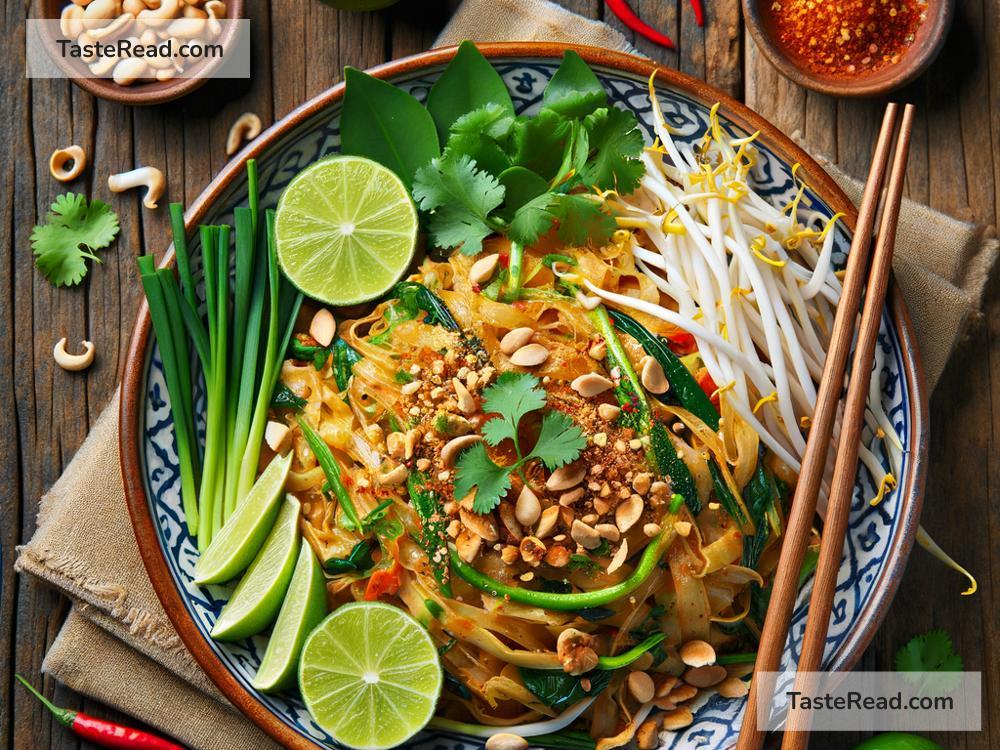How to Prepare Authentic Thai Pad Thai in Simple English
If you love Thai food, chances are you’ve tried Pad Thai, one of Thailand’s most famous dishes. It’s a perfect balance of flavors: sweet, salty, sour, and just a hint of spice. The best part? You can make it at home with simple ingredients and a bit of practice. In this article, we’ll show you step-by-step how to prepare authentic Pad Thai in easy-to-follow language. Let’s get cooking!
What Is Pad Thai?
Pad Thai is a stir-fried rice noodle dish that originated in Thailand. It’s typically made with rice noodles, eggs, tofu, shrimp, or chicken, along with a flavorful sauce made from tamarind, fish sauce, and sugar. The dish is topped with roasted peanuts, lime, and fresh bean sprouts for added texture and taste.
Pad Thai is popular because it’s quick to make and delicious. It’s also highly customizable, so you can adjust the ingredients based on your preferences.
Ingredients for Authentic Pad Thai
Here’s what you’ll need to make a traditional Pad Thai:
For the Sauce:
- 2 tablespoons tamarind paste (adds a sour, tangy flavor)
- 3 tablespoons fish sauce (salty and savory)
- 1 ½ tablespoons palm sugar (or substitute with brown sugar)
- 1 teaspoon soy sauce (optional for extra depth)
For the Pad Thai:
- 6 ounces dried rice noodles (thin, flat noodles; soak them in warm water for 30 minutes or as instructed)
- 2 tablespoons cooking oil (such as vegetable oil or peanut oil)
- 2 cloves garlic, minced
- 1 shallot, finely chopped
- 1 egg (scrambled directly in the wok)
- ½ cup firm tofu, cubed
- 6-8 shrimp (peeled and deveined; substitute with chicken or omit for a vegetarian version)
- 2 cups bean sprouts
- ¼ cup roasted peanuts, chopped
- 3 scallions, sliced
- Lime wedges (for serving)
Optional Garnishes:
- Red chili flakes (for spice)
- Fresh cilantro leaves
Step-by-Step Recipe for Pad Thai
Step 1: Prepare the Pad Thai Sauce
The sauce is the magic behind authentic Pad Thai! Mix tamarind paste, fish sauce, palm sugar, and soy sauce together in a small bowl until the sugar dissolves. Taste it to make sure you like the balance of sweet, sour, and salty flavors. Set the sauce aside for later.
Step 2: Prepare the Noodles
Soak the dried rice noodles in warm water for about 30 minutes, or until they’re soft but not too mushy. Drain and set them aside. Don’t overcook them—Pad Thai noodles finish cooking in the wok.
Step 3: Start Cooking
Heat a large wok or frying pan over medium-high heat. Add 2 tablespoons of cooking oil and let it get hot.
Step 4: Cook the Aromatics
Add the minced garlic and chopped shallot to the hot oil. Stir them for about 30 seconds until fragrant, but be careful not to burn them.
Step 5: Cook the Protein
Add the tofu cubes and shrimp (or chicken) to the wok. Stir-fry for 2-3 minutes until the shrimp turn pink and are cooked through. Remove the protein mixture from the wok and set it aside.
Step 6: Scramble the Egg
Add a little more oil if the wok looks dry. Crack the egg into the wok and scramble it quickly with a spatula. Once the egg is mostly cooked, push it to one side of the wok.
Step 7: Add the Noodles and Sauce
Add the soaked noodles to the wok. Pour the prepared Pad Thai sauce over the noodles and toss everything together. Keep stirring and tossing to coat the noodles evenly with the sauce.
Step 8: Add Protein and Veggies
Add the cooked tofu, shrimp, or chicken back into the wok. Toss everything together. Stir in the bean sprouts and scallions, cooking for another 1-2 minutes.
Step 9: Plate and Garnish
Scoop your Pad Thai onto plates (or bowls). Sprinkle generously with chopped roasted peanuts. Serve with lime wedges on the side—squeeze some lime juice over the noodles for an extra pop of flavor. If you like spice, sprinkle red chili flakes on top.
Tips for Making Great Pad Thai
-
Work Quickly: Pad Thai cooks fast, so make sure all your ingredients are prepped and ready before you start.
-
Use a Wok: If possible, use a wok for better heat distribution and easy tossing, but a large frying pan works too.
-
Customize the Flavors: Adjust the sauce ingredients to suit your taste. Some people like it sweeter, saltier, or tangier.
-
Don’t Overcook the Noodles: Rice noodles can turn mushy if overcooked. Soaking them in warm water before stir-frying is key.
Enjoy Your Homemade Pad Thai!
Congratulations—you’ve just made authentic Pad Thai at home! With practice, you’ll perfect the balance of flavors and the stir-frying technique. This dish is great for weeknight dinners or to impress guests with your cooking skills.
Pad Thai is not just a meal; it’s a delightful adventure into Thai cuisine. By making it at home, you’ll appreciate the rich flavors and simplicity that make this dish so iconic. Grab your chopsticks or fork and enjoy every bite!
Do you have a favorite Pad Thai recipe or tips for making it? Share in the comments below!


